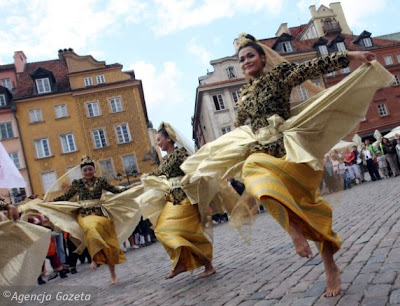Zapin (Jawi: زافين) is a dance form that is popular in Malaysia (especially in the state of Johor, Pahang and Selangor) and in Indonesia, especially in Malay-populated provinces in Sumatera (Riau Province, Jambi province, Riau Islands Province, North Sumatera, and Bangka-Belitung Islands) and West Kalimantan. It is believed to have been introduced by Arab, Muslim missionaries from the Middle East in the fourteenth century.
In the old days, only males were allowed to perform; nowadays, female dancers are included. It used to be performed exclusively for religious ceremonies but through the years it has become a form of traditional entertainment, hence the participation of female dancers is allowed.
The dancers usually perform in pairs and are accompanied by a traditional music ensemble which normally consists of the gambus, accordion, rebab, marwas (bongos), rebana (drum) and dok.
There are numerous types of zapin, and each type varies by the movement and style of dance:
Zapin Melayu Johor
Zapin Pulau
Zapin Tenglu
Zapin Tenglu 2
Zapin Lenga
Zapin Pekajang
Zapin Arab
Zapin Jambi (Jambi Province)
Zapin Singapura
Zapin Sindang (Sarawak)
Zapin Sekaki (North Sumatera)
Zapin Pesisir (Riau Islands Province)
Zapin Tembung (West Kalimantan)









Tidak ada komentar:
Posting Komentar